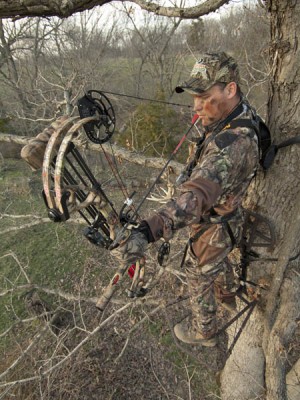Todd Carter Bowhunts the “Hammer Buck”
John E. Phillips 03.19.13

Author’s note: Todd Carter of Oldham County, Kentucky manages about 7,500 acres for wildlife and has one 800-acre farm he manages intensively. He’s been a PSE pro and also on the Mossy Oak Pro Staff.
Hammer was a deer we’d been watching for three years that traveled to other properties too. We all had agreed to let him pass until he got to be an older-age-class buck. The first year, we got good trail camera pictures of him. He was two-and-a-half to three years old and scored 130 or more Boone & Crockett. The next year we had trail camera pictures of him he was a 12-point, and his rack looked bigger. We found his sheds, which scored about 157 B&C. The next year he was scoring 178 B&C, so we decided to put him on the hit list.
Hammer was in a thick cover bedding area and was going toward water. On the farms I manage, there isn’t much water, so we try to take the bucks in between the bedding area and the ponds where they water. This way we don’t disturb the bedding area or the watering sites. This buck had developed a scrape and a rub line out of the thicket, going toward the water. I took this buck at 15 yards with my PSE Evo by hitting him right behind the shoulder. He ran about 150 yards.
Once again, I believe the secret for consistently taking trophy bucks is to know what bucks you have on your property, watch them over an extended time using trail cameras and make sure they have enough food. This way they can reach their maximum potential. If you keep up with your property’s doe numbers and keep bucks from competing with better bucks, you won’t have dispersal (deer leaving your property). The final element to taking a trophy buck like this one is once you gather all the information you can about him, don’t hunt him until all the wind and the weather conditions are right and are stacked in your favor.
 You can’t have trophy bucks on your property, if you don’t fulfill all the management requirements to produce them. We plant Mossy Oak BioLogic year-round to ensure there’s plenty of food for the deer on the property. We keep our doe numbers in check. Once we identify a buck we feel has trophy potential, we learn all we can about that buck. We allow him to live long enough to produce the body weight and antler development that we want him to have. If you’re patient and let that buck become a five- or a six-year-old, you not only have produced a trophy buck. At that point, you also will know where to put your stand and at about what time the buck should appear. If you set up your stand within 20 yards or less of where the deer will be, and if you’re shooting a fast, flat-shooting bow like the PSE Evo, you can expect to harvest trophy bucks regularly.
You can’t have trophy bucks on your property, if you don’t fulfill all the management requirements to produce them. We plant Mossy Oak BioLogic year-round to ensure there’s plenty of food for the deer on the property. We keep our doe numbers in check. Once we identify a buck we feel has trophy potential, we learn all we can about that buck. We allow him to live long enough to produce the body weight and antler development that we want him to have. If you’re patient and let that buck become a five- or a six-year-old, you not only have produced a trophy buck. At that point, you also will know where to put your stand and at about what time the buck should appear. If you set up your stand within 20 yards or less of where the deer will be, and if you’re shooting a fast, flat-shooting bow like the PSE Evo, you can expect to harvest trophy bucks regularly.
For more information on hunting deer, get John E. Phillips’ new eBook “Bowhunting Deer: The Secrets of the PSE Pros.” You can go to http://www.amazon.com/kindle-ebooks, type in the name of the book, and download it to your Kindle, and/or download a Kindle app for your iPad, SmartPhone or computer.

